The Living Future Institute with Jacob Bloom, LFA
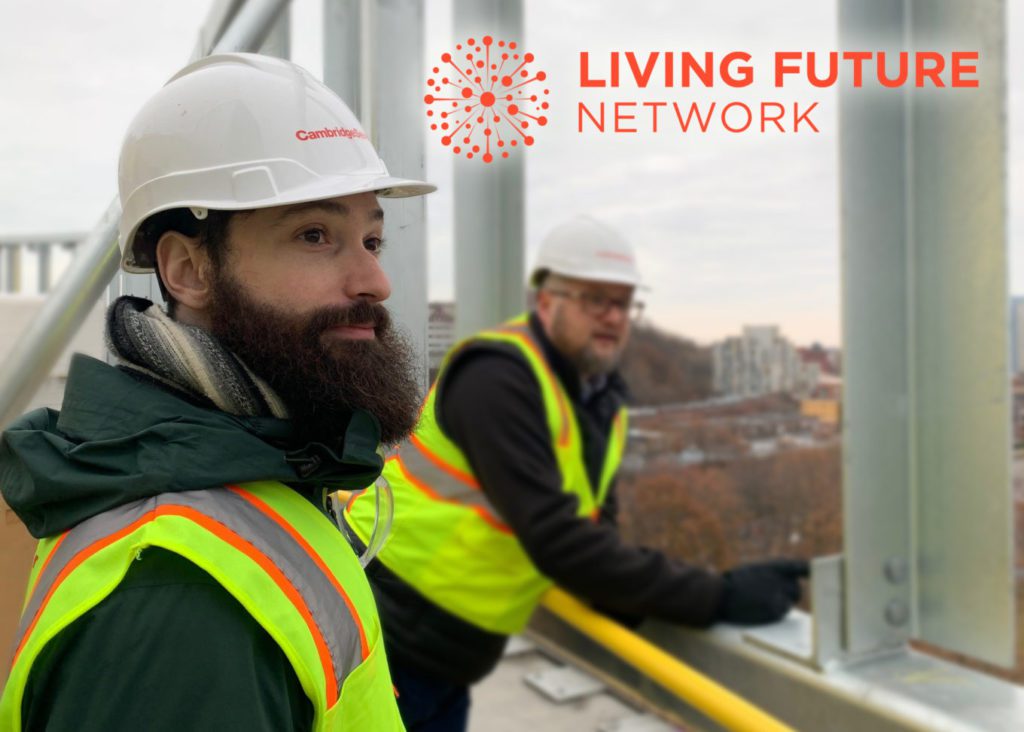
Petals may be the harbinger of Spring but in our recent conversation with Jacob Bloom, LFA we learned that some also carry a bigger message: saving our planet, positively.
Listen in as Jacob, a Living Building Ambassador, guides us through the ambitious sustainable programs from the International Living Future Institute and discusses the steps and decisions we can take to achieve petal parity. CambridgeSeven is proud of our commitment to the Living Building Challenge, part of our ongoing focus on the far-reaching implications that our design choices can have on our community and the planet.
Listen to the interview or read the transcript below.
There’s a lot more to sustainable design than just picking green materials. As architects, we understand there is even a direct correlation between building a better built environment and increasing equity. I’m Chelsea and today I’m speaking with our own Living Building Ambassador, Jacob Bloom to connect the dots for us.
Chelsea Gazaille
Hi, Jacob, how are you?
Jacob Bloom
I’m good. How are you?
Chelsea Gazaille
I’m doing well. Thank you for joining me for this little talk.
Jacob Bloom
Thanks for having me.
Chelsea Gazaille
Of course! So for the listeners and the readers, can you first give us a little background? And tell us what is the Living Building Challenge?
Jacob Bloom
Sure. The Living Building Challenge is a green building certification, organized by the International Living Future Institute. It uses the metaphor of a flower to try and create buildings and certify buildings that create a positive impact on the environment and on our communities. And they do that with the metaphor of a flower. And so they look at seven categories or petals, and look at how each of those categories can have a positive impact.
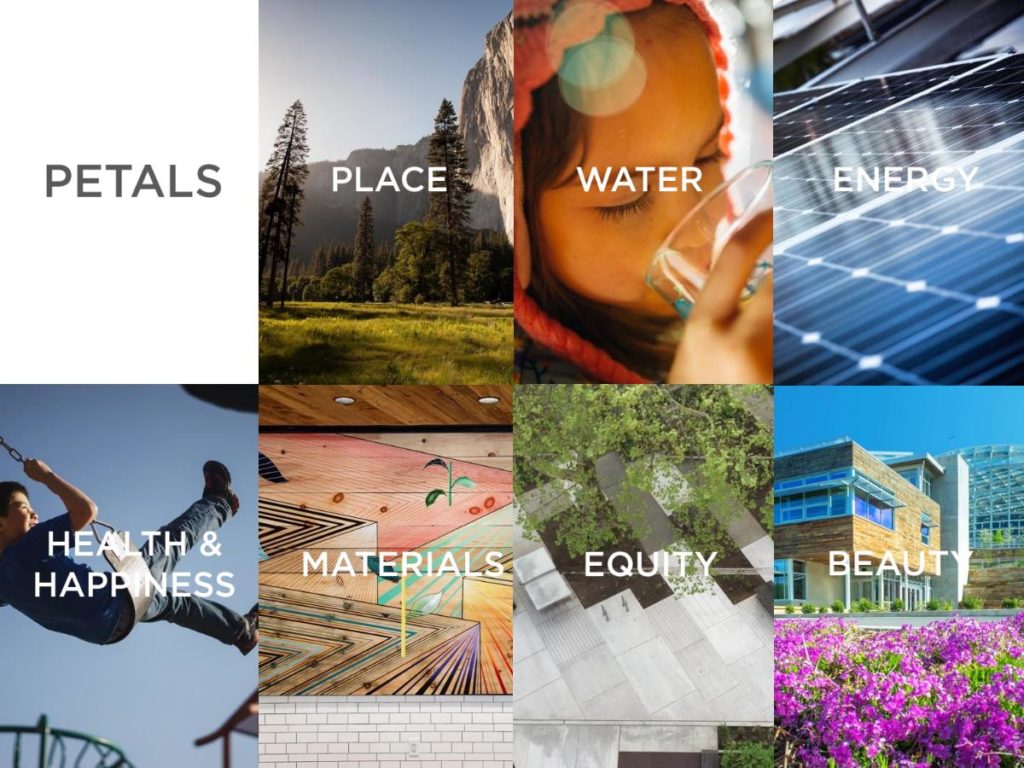
Chelsea Gazaille
Great. So it’s not just about reducing negative impact, this is about actually increasing positive impacts that buildings might have. Fantastic. So that’s a good overview. Now, can you just tell us, why were you interested in becoming Living Future Accredited?
Jacob Bloom
I don’t think when I went to the first Living Building Challenge workshop that I knew what I was really getting into……the architectural community has known about the importance of sustainability for a really long time, we’ve been incorporating it into our projects. And I was interested in learning about a new program. And I went, and I was really struck by a fundamentally different way of thinking about sustainability, that this wasn’t about minimizing our impact. It’s about creating a positive impact. And I really appreciated the holistic nature of it, that it wasn’t just about carbon footprint or reducing water, it also looks at the idea of materials’ ingredients and how they can affect human health. And the idea that environmental sustainability has a lot of impacts on equity of marginalized communities — that marginalized communities are disproportionately affected by the severe weather events that are happening more and more often with climate change, and they’re more likely to be impacted by toxic chemicals and materials. So I thought this was really a profound idea that net zero is not the goal. The goal is not to be neutral, it’s to create buildings that are good. And living buildings are a tool to help us get there.
Chelsea Gazaille
All right, well, that sounds like a really great initiative. And it sounds like you’re really passionate about it, which is fantastic. So I understand the goal. I understand the mission of Living Future. But what is a ‘living building’? How do you make a building ‘living’?
Jacob Bloom
That’s an excellent question. Living buildings aren’t actually alive, although parts of them may be. But a Living Building is a building that meets all 20 imperatives of the seven categories of the Living Building Challenge. And so there are seven petals of the Living Building Challenge: place, water, energy, health & happiness, materials, equity & inclusion, and beauty. And so within those seven petals, the Living Building Challenge is really trying to set really high targets that help a building have a positive impact. So, we’re not working towards net zero, we’re working towards buildings that are creating more renewable energy on site than they’re using; buildings that are collecting all of their water from the site, either from rain or from the aquifers underground, they’re processing all of that water on site, treating it without chemicals. They’re using it and then they’re cleaning it and re-infiltrating it into the ground. So they’re completely separate from the municipal water system and municipal sewer system.
We’re looking for projects that are eliminating toxic chemicals from their building materials, for both the effect on the health of people in the building, as well as people throughout the whole supply chain: people in the manufacturing plants and who live around these manufacturing plants or may be involved in the extraction of materials from the earth.
We want to create buildings that are universally accessible to everyone; that no one is discriminated against based on their background, race, age, ability, or socio-economic class. In order to create a living future, we have to create a future that’s for everyone.
The Institute recognizes that meeting all 20 of these imperatives may not be feasible for all projects, and so they’ve pulled out 10 that they consider the most critical imperatives. And if you meet all 10 of those imperatives, the building can be a Core Green Building Certified building. Or once you’ve met those 10, you can also go on to certify individual petals for water, energy or materials. And if you meet all 20, then you’re fully Living Certified.
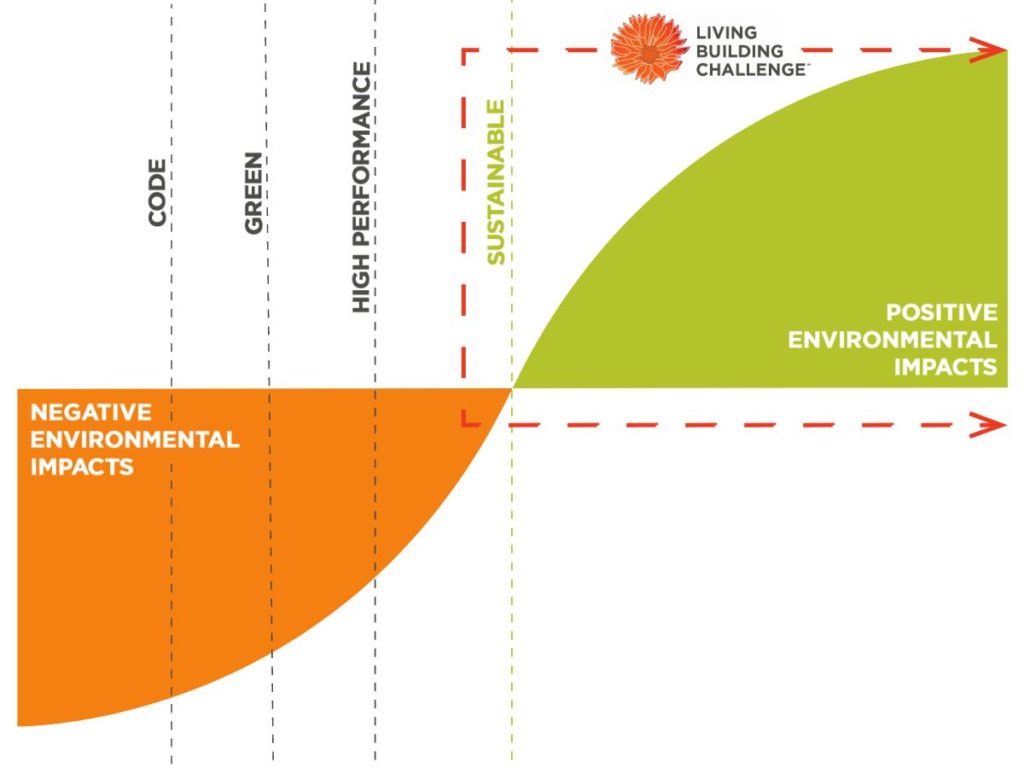
Chelsea Gazaille
So that’s a lot of targets to become a Living Building. That’s a lot of different targets across different topics that someone has to meet.
Jacob Bloom
Yeah, that’s really the idea of the Living Building Challenge, trying to create buildings that are holistically positive. It’s not just about one category, it’s about everything.
Chelsea Gazaille
And as a design professional, you have to hold all of that in your head all at once — you can never be thinking just about one specific silo of a building design, like you’re thinking about the materials and the occupants and the site and the community and the impacts on resource consumption. You speak pretty thoroughly about all of these topics and that’s because you’re not just an accredited professional, you’re also an ambassador, right?
Jacob Bloom
Yeah. As the Living Future ambassador, I volunteer for the Institute to give presentations on all of their programs, including the Living Building Challenge, but also their two other challenges: the Living Community Challenge that takes these same seven petals and looks at expanding them into whole neighborhoods, districts, or campuses, and what the effects of those petals are in terms of re-wilding our cities, or to create a whole district that’s net-positive water, net-positive waste; and the Living Product Challenge, which looks at applying these petals to the building materials that we’re building out of. Because that’s a really fundamental part of creating a sustainable building is the products that go into it. I also do presentations as an ambassador on their other green building certifications, which are their Zero Carbon Certification and their Zero Energy Certification and the Core Green Building Certification. And then they have three transparency labels: the Declare Label, which is like a materials ingredients list for building products; they have the Just Label, which is a social justice, transparency label for organizations; and they have the Reveal Label, which is a building performance transparency label for buildings.
Chelsea Gazaille
Okay, so that’s a lot of different kinds of knowledge bases that you are responsible for putting out in the world and convincing other people that this is a worthwhile investment.
Jacob Bloom
Yeah, it’s a lot of different aspects, but they’re all really tied together. They’re all looking at the same things — all the green building certifications are looking at the same goals of being net zero carbon, or net zero energy, or net positive. And the transparency labels are all components of that, right? We can’t have buildings with no toxic ingredients in them if we don’t know what the ingredients in those products are. We don’t know how we can create buildings that are socially just if we don’t have some sort of transparency on what that means. So all of these things are tied together.
Chelsea Gazaille
Right, right. So, just as someone listening in and learning about all this stuff, obviously, it sounds great, that everybody should be building this way and having these initiatives and monitoring what goes into their buildings. So why should people buy into this, though? What’s the benefit for the owner or the client? Why should they invest in this kind of thing?
Jacob Bloom
So there are different incentives for different groups. Some owners already have a sustainable agenda that they’re trying to meet, they have sustainability targets to be net zero by the year 2050, or zero carbon by 2050. That happens a lot with universities, and that sort of client. And by building living buildings, they’re working towards those sustainability goals. They’re showcasing their innovation, and they’re showcasing their commitment to other peers within the community, as well as potential students who might want to come to their campus.
Some owners have different incentives. Developers are looking at creating buildings that are attractive to tenants. They’re looking at reducing their utilities– being net-zero -energy and net-zero-water work towards those goals. They’re all also creating buildings that are healthy. And we know that creating buildings with access to natural light and access to nature make people more productive. And that’s really a way of attracting tenants to their spaces.
And then there are cities who have sustainability goals as well. And by encouraging living buildings, by offering zoning incentives to build higher or build larger, they are helping reach those sustainability goals. They’re also taking the pressure off of their public utilities by taking buildings off of their municipal water system, by taking buildings off of their electric grid. They’re reducing the load on a lot of those public services.
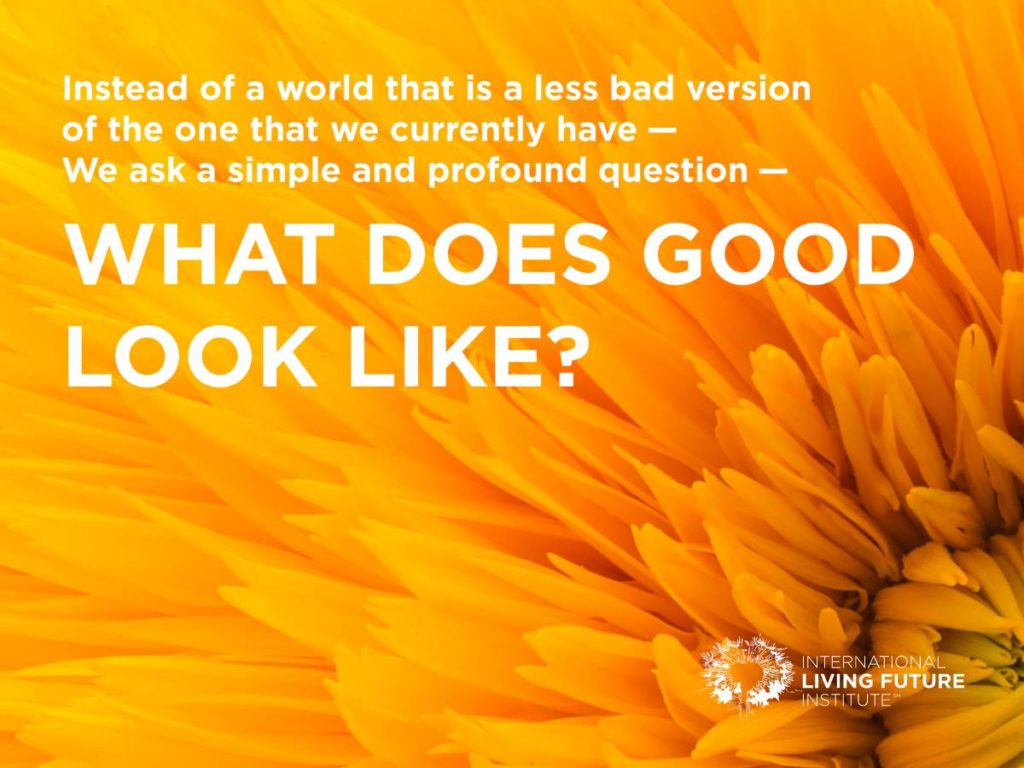
Chelsea Gazaille
Awesome. That all sounds like great incentives for a lot of different stakeholders. And I think, especially right now, people are much more aware of how healthy their buildings are, especially because everybody’s spending a lot more time inside these days. I think going forward, this is going to become an ever-increasingly important issue of how buildings affect the health of their occupants, not just with natural ventilation, which is a really big topic, but also with material choices, since we’re surrounded by these materials every day of your life, you want to know what’s in them.
Jacob Bloom
We spend 90% of our time inside. So the products that are around us–the materials that they’re made of–those chemicals are really having a huge effect on our health.
Chelsea Gazaille
I think the more people know, the more they’ll value what is in their buildings. And I know that CambridgeSeven has recently kicked off a really rigorous initiative to improve our own material specifications. Can you just tell us what’s the deal with that? And what’s the goal here?
Jacob Bloom
For many months now, we’ve been working on updating the way that we choose materials, to choose healthier materials, to choose more sustainable materials. Recognizing that, yes, we care about the carbon footprint of the materials that we’re using, we care about the amount of water that goes into them, we care about how they get recycled at the end of their life. We also care about the ingredients that are in them, and how that affects the health of the people in our buildings, and the health of the communities all along the supply chain.
We recognize that, as unfortunate as it is, slave labor is still prevalent in a lot of manufacturing processes. And that’s not acceptable. We recognize that these toxic chemicals that are going into building products are disproportionately affecting communities around those manufacturing plants that predominantly are black, indigenous, and people of color, that the materials we choose are an equity issue as much as they are a climate change issue.
And recognizing all of this, the International Living Future Institute put together a group of 50 manufacturers to talk about how they could make their products more sustainable. And these 50 manufacturers committed to making more sustainable products, more environmentally friendly products, more healthy products, and really investing in these aspects of manufacturing. And as part of that, they put out an open letter to the design community asking for us to commit back to them that we cared about this. They were committed, but they needed to know that if they went through and they made these changes to their products, that we would use them. And so, CambridgeSeven recently signed a materials’ pledge that said, yes, we care about these products. And we will continue to specify products that are better for human health, that are more equitable, that have a lower carbon footprint. These are things that matter and we will incorporate into our projects going forward.
Chelsea Gazaille
Awesome. It’s really great to see and learn about such a large group of people in this industry, working together and trying to come up with better solutions for how we build. So at this point, our firm has signed this material pledge, we’re also signatories of the AIA 2030 challenge. And our firm’s signed a letter on behalf of the AEC industry to implore the Biden Administration’s Build Back Better plan to address more about the built environment. So we have a lot of these initiatives and a lot of these plans. But what are some ways that we’re walking the walk — what are some projects that we have right now that reflect all of these initiatives?
Jacob Bloom
So I think that all of our projects are addressing sustainability in some form or another. I’ve been spending the past few years on the new Hilton Garden Inn in Brookline and that was something we designed to meet the LEED silver standards. And we did that through building performance, obviously, but also through selecting materials that have a better impact on the indoor air quality of the building, by doing rainwater capture for irrigation. I’m also working on a new residential and hotel development in Coolidge Corner, also in Brookline. And there, we’re still very early in design, we’re still figuring out what the sustainable aspects of this project are going to be. And then we’ve also got Expedition Blue, which is a very different scale of project down in Cape Cod. And we just registered that for the International Living Future Institute Core Green Building Certification. So that’s really exciting to see how that all moves forward.
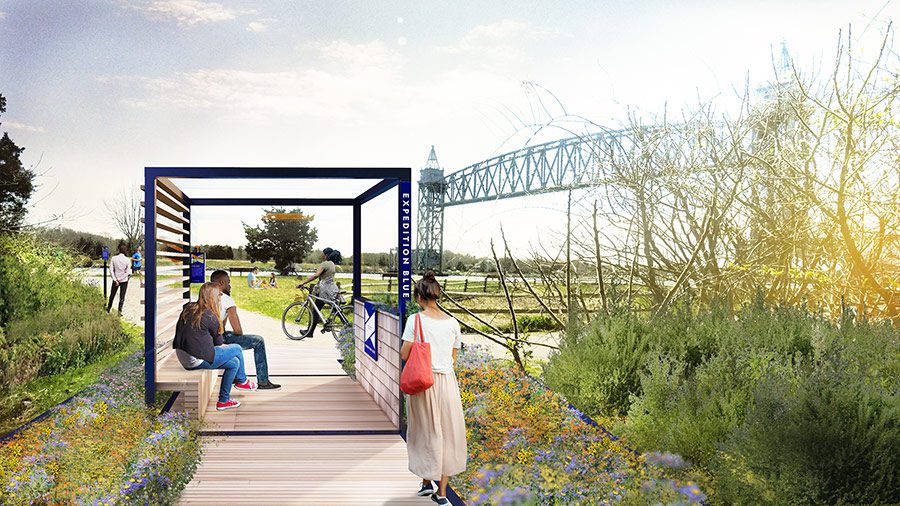
Chelsea Gazaille
The first unveiling of Expedition Blue is coming up this summer so I think everyone’s really excited to see those installations pop up along the coast. Also, congratulations on the Hilton Garden Inn just opening. Very exciting.
Jacob Bloom
Yeah, it is.
Chelsea Gazaille
Okay, well, that was all super informative. And I just want to thank you for sharing your Living Future knowledge with us. It’s all very, very inspiring.
Jacob Bloom
I agree. I think that this is really the way that we move forward. And it’s exciting to see more and more projects reaching for these goals.
Chelsea Gazaille
Yes, definitely. Thanks Jacob and Happy Earth Day.
Jacob Bloom
Happy Earth Day!